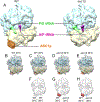Critical Role for Saccharomyces cerevisiae Asc1p in Translational Initiation at Elevated Temperatures
- PMID: 30285306
- PMCID: PMC6461043
- DOI: 10.1002/pmic.201800208
Critical Role for Saccharomyces cerevisiae Asc1p in Translational Initiation at Elevated Temperatures
Abstract
The eukaryotic ribosomal protein RACK1/Asc1p is localized to the mRNA exit channel of the 40S subunit but lacks a defined role in mRNA translation. Saccharomyces cerevisiae deficient in ASC1 exhibit temperature-sensitive growth. Using this null mutant, potential roles for Asc1p in translation and ribosome biogenesis are evaluated. At the restrictive temperature the asc1Δ null mutant has reduced polyribosomes. To test the role of Asc1p in ribosome stability, cryo-EM is used to examine the structure of 80S ribosomes in an asc1Δ yeast deletion mutant at both the permissive and nonpermissive temperatures. CryoEM indicates that loss of Asc1p does not severely disrupt formation of this complex structure. No defect is found in rRNA processing in the asc1Δ null mutant. A proteomic approach is applied to survey the effect of Asc1p loss on the global translation of yeast proteins. At the nonpermissive temperature, the asc1Δ mutant has reduced levels of ribosomal proteins and other factors critical for translation. Collectively, these results are consistent with recent observations suggesting that Asc1p is important for ribosome occupancy of short mRNAs. The results show the Asc1 ribosomal protein is critical in translation during heat stress.
Keywords: ASC1; initiation; ribosome; translation; yeast.
© 2018 WILEY-VCH Verlag GmbH & Co. KGaA, Weinheim.
Conflict of interest statement
Figures






Similar articles
-
Capturing the Asc1p/Receptor for Activated C Kinase 1 (RACK1) Microenvironment at the Head Region of the 40S Ribosome with Quantitative BioID in Yeast.Mol Cell Proteomics. 2017 Dec;16(12):2199-2218. doi: 10.1074/mcp.M116.066654. Epub 2017 Oct 5. Mol Cell Proteomics. 2017. PMID: 28982715 Free PMC article.
-
Yeast Asc1p and mammalian RACK1 are functionally orthologous core 40S ribosomal proteins that repress gene expression.Mol Cell Biol. 2004 Sep;24(18):8276-87. doi: 10.1128/MCB.24.18.8276-8287.2004. Mol Cell Biol. 2004. PMID: 15340087 Free PMC article.
-
Asc1p/RACK1 Connects Ribosomes to Eukaryotic Phosphosignaling.Mol Cell Biol. 2017 Jan 19;37(3):e00279-16. doi: 10.1128/MCB.00279-16. Print 2017 Feb 1. Mol Cell Biol. 2017. PMID: 27821475 Free PMC article.
-
Communication between RACK1/Asc1 and uS3 (Rps3) is essential for RACK1/Asc1 function in yeast Saccharomyces cerevisiae.Gene. 2019 Jul 20;706:69-76. doi: 10.1016/j.gene.2019.04.087. Epub 2019 May 1. Gene. 2019. PMID: 31054365 Free PMC article.
-
Regulation of eukaryotic translation by the RACK1 protein: a platform for signalling molecules on the ribosome.EMBO Rep. 2004 Dec;5(12):1137-41. doi: 10.1038/sj.embor.7400291. EMBO Rep. 2004. PMID: 15577927 Free PMC article. Review.
Cited by
-
ApWD40a, a Member of the WD40-Repeat Protein Family, Is Crucial for Fungal Development, Toxin Synthesis, and Pathogenicity in the Ginseng Alternaria Leaf Blight Fungus Alternaria panax.J Fungi (Basel). 2025 Jan 14;11(1):59. doi: 10.3390/jof11010059. J Fungi (Basel). 2025. PMID: 39852478 Free PMC article.
-
Control of Translation at the Initiation Phase During Glucose Starvation in Yeast.Int J Mol Sci. 2019 Aug 19;20(16):4043. doi: 10.3390/ijms20164043. Int J Mol Sci. 2019. PMID: 31430885 Free PMC article. Review.
-
The Beak of Eukaryotic Ribosomes: Life, Work and Miracles.Biomolecules. 2024 Jul 22;14(7):882. doi: 10.3390/biom14070882. Biomolecules. 2024. PMID: 39062596 Free PMC article. Review.
-
The Proteomic Analysis of Cancer-Related Alterations in the Human Unfoldome.Int J Mol Sci. 2024 Jan 26;25(3):1552. doi: 10.3390/ijms25031552. Int J Mol Sci. 2024. PMID: 38338831 Free PMC article.
References
Publication types
MeSH terms
Substances
Grants and funding
LinkOut - more resources
Full Text Sources
Molecular Biology Databases

